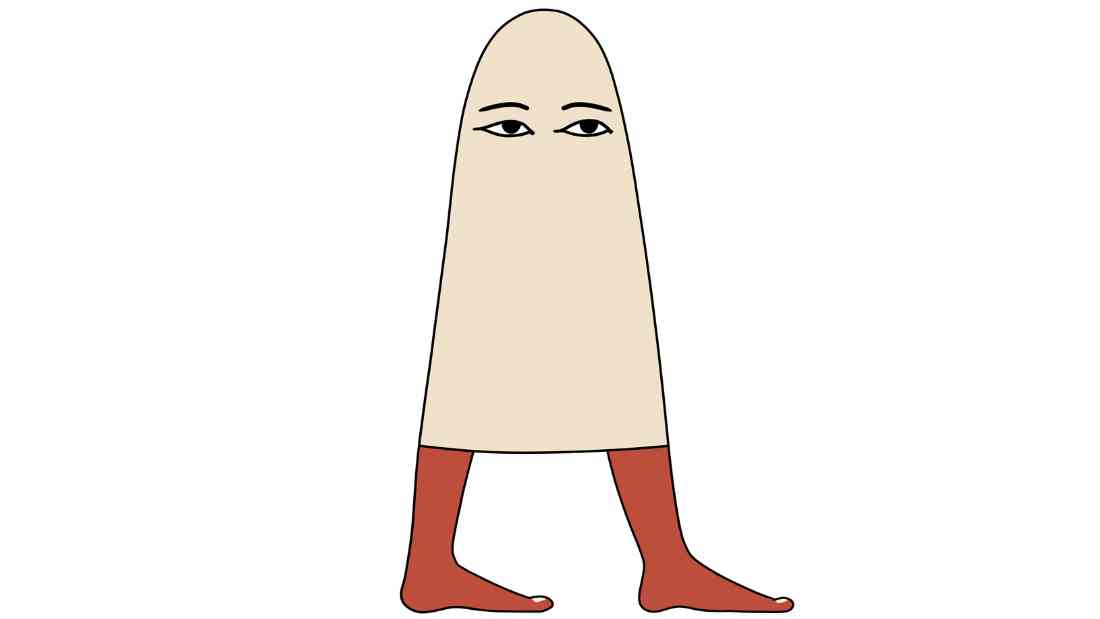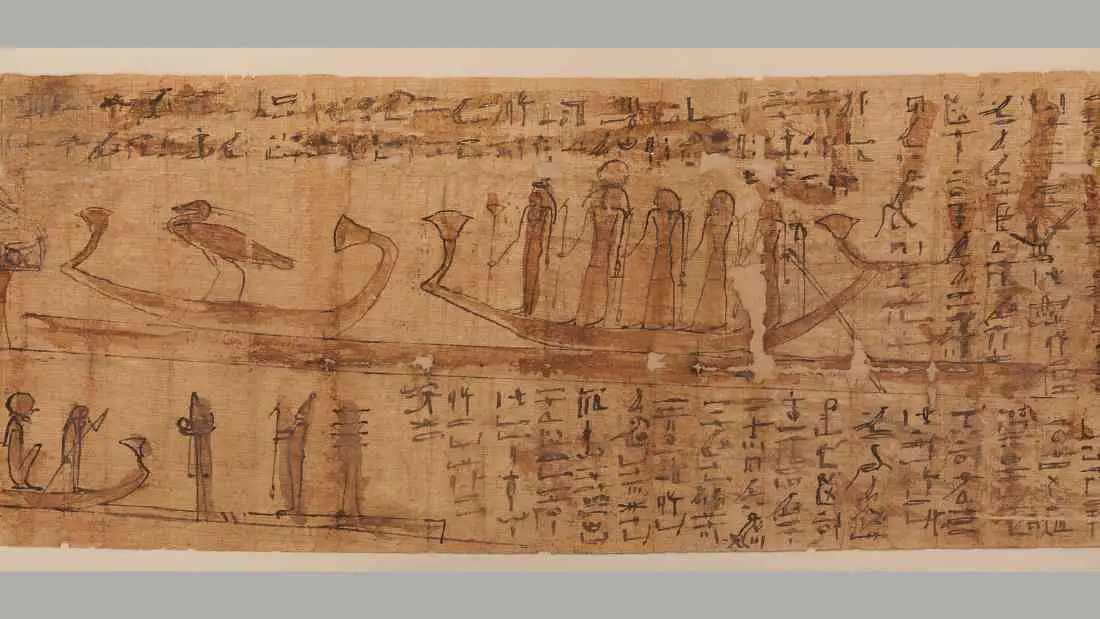The pantheon of ancient Egyptian gods is filled with fascinating deities, each with their own unique significance and role. Among these gods, Medjed stands out as one of the more enigmatic and lesser-known figures. While often overshadowed by more prominent gods such as Ra or Isis, the Egyptian god Medjed holds a vital role in Egyptian mythology as the guardian of Osiris and the afterlife.

Origins and Depiction
Medjed, also known as Merged, first appeared during the New Kingdom period of ancient Egypt (1550-1077 BCE).
The name “Medjed” translates to “the smiter” or “the subduer,” suggesting a powerful and protective deity. While specific details regarding Medjed’s origins remain elusive, his depiction provides some insight into his symbolism and purpose.
Medjed is typically portrayed as a squatting or kneeling figure, emphasizing his connection to the earth and the afterlife.
He is often depicted wearing a striped cloak that conceals most of his body, evoking a sense of mystery and intrigue.
In some depictions, Medjed is depicted holding a staff or scepter, symbolizing his authority and power.
These attributes indicate his role as a guardian and protector, ensuring the safety and well-being of the deceased on their journey to the afterlife.
The staff or scepter represents his ability to subdue any malevolent forces and guide souls through the perilous challenges they may face in their journey.
Medjed: Guardian of Osiris
One of Medjed’s primary roles in Egyptian mythology is as the guardian of Osiris, the god of the afterlife, resurrection, and fertility.
Osiris, a central figure in the Egyptian belief system, represents the cycle of life, death, and rebirth.

As the ruler of the underworld, Osiris required a guardian to protect the realm of the dead, and Medjed fulfilled this crucial duty.
Medjed’s presence as the guardian of Osiris and the afterlife highlights his role in ensuring the safety and well-being of deceased souls.
It is believed that he played a significant role in protecting the souls of the departed during their journey through the various stages of the afterlife.

The Egyptian God Medjed – Guardian in the Afterlife
In the ancient Egyptian funerary text known as the Book of the Dead, Medjed holds a significant role in guiding and protecting the souls of the deceased on their journey to the afterlife.
The Book of the Dead, also known as the Book of Coming Forth by Day, was a collection of spells and rituals aimed at assisting the deceased in navigating the challenges they would face in the afterlife.
Medjed is often mentioned in Chapter 17 of the Book of the Dead, which focuses on the judgment of the soul.
In this chapter, Medjed is described as a powerful deity who stands as a defender and helper before Osiris, the god of the afterlife.
“I know the name of that Smiter among them, who belongs to the House of Osiris, who shoots with his eye, yet is unseen.”
Book of the Dead
Medjed’s presence ensures that the deceased receives a fair judgment and are granted passage into the realm of the dead.

Additionally, Medjed’s role in the Book of the Dead extends beyond judgment.
He is also depicted as a protector throughout the various stages of the afterlife journey described in different chapters of the text.
As the souls encounter demons, obstacles, and challenges, Medjed stands as their guardian, offering guidance and safeguarding them from harm.
The inclusion of Medjed in the Book of the Dead underscores his crucial role in Egyptian belief regarding the afterlife.
He represents the protective forces that accompany the souls in their journey, ensuring their safe passage and aiding them in their quest for eternal life.
The presence of Medjed offered solace and reassurance to the Egyptians, who held a deep reverence for the afterlife.
Knowing that a vigilant guardian such as Medjed was watching over their departed loved ones provided comfort and assurance during times of grief and loss.

Medjed Beyond Ancient Egypt
The Greenfield Papyrus is an ancient Egyptian manuscript that contains illustrations from the “Book of the Dead.”
It is one of the longest and most beautifully illustrated surviving manuscripts of this funerary text.
The papyrus dates back to the Third Intermediate Period (950s-930s BCE) and is currently housed in the British Museum.
In 2012, the Greenfield Papyrus illustrations were put on display at the Mori Art Museum in Tokyo and the Fukuoka Museum of Art.
This exhibition introduced Medjed, among other Egyptian gods, to a wider audience and caught the attention of the Japanese public.
Following the exhibition, the Egyptian god Medjed became an internet meme sensation in Japan.
The Ancient Egyptian god’s distinctive appearance, with his squatting figure and obscured features, captured the imagination of internet users, leading to the creation of various memes centered around the deity.
These memes often depicted Medjed as a cute and ghost-like character, transforming the ancient Egyptian god into a playful and relatable figure.
The humorous and lighthearted nature of these memes resonated with people, resulting in their widespread sharing and circulation on social media platforms and websites.

Conclusion
The ancient Egyptian god Medjed holds a significant role in Egyptian mythology as the guardian of Osiris and the afterlife.
With his enigmatic appearance and mysterious origins, Medjed symbolizes protection, guidance, and reassurance for the journey to the realm of the dead.

Frequently Asked Questions About The Egyptian God Medjed
Medjed is an ancient Egyptian deity that first appeared during the New Kingdom period (1550-1077 BCE). He is often referred to as “the smiter” or “the subduer,” suggesting a powerful and protective nature.
Medjed played a significant role as a guardian and guide in the afterlife. He ensured the safe passage of souls and protected them from malevolent forces on their journey to the realm of the dead.
Medjed is typically portrayed as a squatting or kneeling figure, often wearing a striped cloak that conceals most of his body. His facial features are obscured, adding to the air of mystery surrounding him. In some depictions, he holds a staff or scepter symbolizing his authority and power.
Medjed is mentioned in the Book of the Dead, an ancient Egyptian funerary text. He is described as a defender and helper, standing before Osiris to ensure a fair judgment for the deceased. Additionally, Medjed serves as a protector throughout the various stages of the afterlife journey described in the book.
Medjed gained popularity in Japan after the exhibition of the Greenfield Papyrus in 2012 at art museums in Tokyo. Internet users in Japan created memes based on Medjed’s distinct appearance, leading to widespread sharing and circulation on social media platforms. These memes often depict Medjed as a cute and ghost-like character, transforming him into a relatable figure in contemporary pop culture.
There are no known temples specifically dedicated to Medjed. He is primarily depicted in funerary contexts and associated with the Book of the Dead.
Posts About the Egyptian Pantheon of Gods
The Pantheon of Ancient Egyptian Gods – A Comprehensive Guide
The Wrath of Montu – The Mythology of the Egyptian War God
Egyptian God Ammit – The Eater of Hearts in Ancient Egyptian Mythology
The Nightly Journey of Khonsu – The Ancient Egyptian God of the Moon
Ihy – The Joyful Ancient Egyptian God of Music
Min – The Ancient Egyptian God of Fertility
The Egyptian God Anubis – His Evolution from Son of Ra to Protector of the Dead
Unraveling the Mysteries of Babi – The Ancient Egyptian Baboon God
Ra, the Egyptian Sun God – Symbolism and Significance in Ancient Egyptian Culture
Sobek: The Ferocious Crocodile God of Ancient Egypt
The Enigmatic Mythology of Horus, the Egyptian Sky God
The Egyptian God Set – Protector of the Desert and Lord of Conflict
The Ancient Egyptian God Medjed: The Guardian of Osiris and the Afterlife
Anput, the Wife and Female Version of Anubis
Selket – The Scorpion Crowned Egyptian Goddess
Shu – The Egyptian God of Air, Wind, Peace and Lions
Hapi the Androgynous Ancient Egyptian God of the Nile
The Egyptian Sky Goddess Nut: Myth and Symbolism
The 42 Laws of Maat: The Moral Principles of the Ancient Egyptians
The Ancient Egyptian Goddess Mut: The Maternal Power in Egyptian Mythology
The Warrior Goddess: Neith in Ancient Egyptian Mythology
The God Bes: The Joyful Dwarf Deity in Ancient Egyptian Culture
The Egyptian Gods of Love: Hathor and Isis in Ancient Egyptian Mythology
Confronting the Serpent: The God Apep, the Nemesis of Ra in Egyptian Myth

